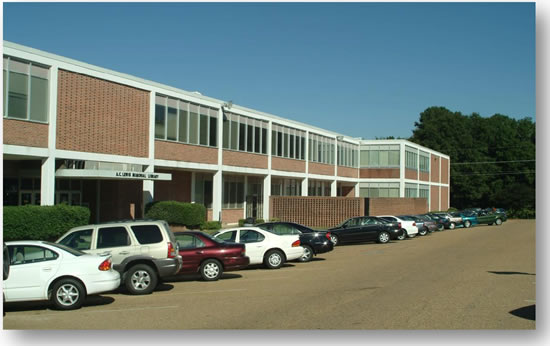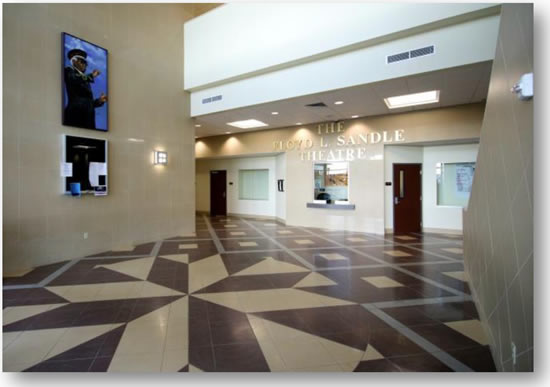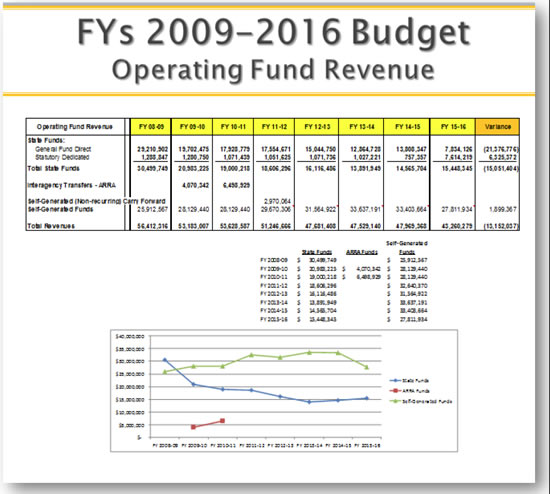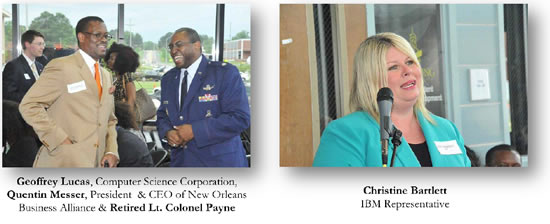The most pressing issues at Grambling State University are: 1) Enhancing Recruitment Efforts, 2) Strengthening Fundraising Strategies, 3) Maintaining Accreditations, 4) Campus Safety and Community Policing 5) Renovating or Rebuilding the Library 6) Developing a Deferred Maintenance Plan 7) Creating a Financial Stabilization and Accountability System, and 8) Creating partnerships and collaborations with business/industry, and Workforce Development. This report addresses current and future actions that will highlight these issues to position the University for growth.
The chart below is according to the Louisiana Board of Regents Fact Book. The data provided indicates that while undergraduate enrollment is declining, graduate enrollment has steadily increased each year. It is important to note that many of the graduate programs offer online courses and courses that are taught after 5:00 p.m. making them more accessible to the students.
Grambling State University
| Enrollment | Profiles | 2007 | 2008 | 2009 | 2010 | 2011 | 2012 | 2013 | 2014 |
| Fall Headcount | 5,210 | 5,282 | 5,025 | 5,008 | 5,219 | 5,282 | 5,085 | 4,518 | |
| % Undergraduate | 91.7% | 91.1% | 90.7% | 88.1% | 85.6% | 84.1% | 82.0% | 78.2% | |
| % Graduate | 8.3% | 8.9% | 9.3% | 11.9% | 14.4% | 15.9% | 18.0% | 21.8% | |
| Annual FTE | 5,062.7 | 5,128.3 | 4,835.9 | 4,889.9 | 5,079.6 | 4,885.2 | 4,603.0 | 4,293.1 | |
| Lower Level FTE | 2,716.7 | 2,648.1 | 2,342.0 | 2,152.4 | 2,085.1 | 2,030.4 | 1,938.9 | 1,800.8 | |
| Upper Level FTE | 2,015.2 | 2,103.3 | 2,098.5 | 2,225.2 | 2,363.0 | 2,160.8 | 1,940.2 | 1,764.9 | |
| Grad FTE | 330.8 | 376.9 | 395.4 | 512.3 | 631.5 | 694.0 | 723.7 | 727.4 | |
| Source: Louisiana Board of Regents 2/20/16 | |||||||||
The University has established an aggressive recruitment plan as well as an energized enrollment management team that evaluates current practices and recommends changes. Social media is being employed more effectively to increase the number of applicants. In addition, databases are being utilized to identify prospective students who are likely to attend Grambling State University. As well, focus groups are held frequently with students to get their input as it relates to recruitment and retention. The feedback is used to improve practices and develop new techniques for attracting and retaining students. In addition, the transcript analysts and processors are focusing on increasing the number of students who transfer from community colleges to Grambling State University.
Although the majority of students enrolled at the University at the undergraduate level are traditional students, they have nontraditional obligations. The traditional time and method of delivering courses are being discussed. The possibility of additional night classes, weekend and more online courses is being explored to accommodate the needs of the diverse student population. These new methods of course delivery and availability should attract a larger population of nontraditional students. Also, the University has a history of attracting international students. Unfortunately, over the past few years, the international student population has decreased from over 600 to around 200 students. The enrollment management team is working towards reestablishing MOU’s with a host of countries.
The University is developing other methods to grow the enrollment which includes the development of new academic programs. One program that is currently being developed in the Department of Criminal Justice is a comprehensive Cyber Security Program under a Title III, Part B grant from the Federal Government. The five (5) year multi-million dollar project focuses on enhancing the Academic Quality of the Bachelor of Science (B.S.) and Masters of Science (M.S.) degree programs. GSU will enhance these programs by incorporating Cyber Security as well as increasing the sustainability of specialized components of Forensic Science, Homeland Security, Advanced Investigative Techniques for Organized Crime, Terrorism and other areas of Crime Prevention and Crime Control.
Retention efforts work in concert with recruitment efforts. The President has established
a pilot program that will be fully integrated into the University structure that addresses
at-risk students. This initiative is known as the President's Student Leadership
Initiative (SLI). The primary goals of this initiative are to improve retention, build
leadership skills, develop persistence in spite of difficulty and opposition, leading
to a timely graduate. All services offered to students through the program are designed
to accelerate the learning curve, escalate personal development, and provide the necessary
preparation for a successful professional career. The ultimate goal of this initiative
is to increase the graduation and retention rates, thereby increasing the Alumni giving
capable.
Students accepted into the SLI program must be a first-year freshman, enrolled full-time
at Grambling State University as of fall semester, 2015, and have a cumulative GPA
of 2.5 or better while demonstrating a commitment to civic and community involvement.
Currently, there is space for 50 students and we are fast approaching our intake goal.
SLI's initial active enrollment includes the Freshmen class President, Miss Freshman,
a writer/photography for the Gramblinite, students that have achieved a 4.0 GPA in
their first semester, and a very accomplished writer who has published her own book
(Ebony Aiken, entitled: A Ray Of Hope), which is in bookstores now, available for
purchase!
With the constant turnover in the administration of the University, it has been difficult to build relationships with various constituent groups that lead to continuous giving. The administration must regain the trust of its constituents toward providing financial contributions to the university.
Grambling State University’s Office of Advancement provides a wealth of opportunities to give back to the University through the Annual Fund Program, Endowments, Parents Fund, and many other giving opportunities. The current major initiatives are:
The President and the Vice President for Advancement continue to build relationships with numerous business and industry constituents. These companies include but are not limited to: Frito Lay, PepsiCo, Coca-Cola, CenturyLink, AT&T, Apple and others.

Four departments and two colleges have faculty or resource needs that are linked to their successful reaffirmation. They are the College of Business and the College of Education, Engineering Technology, Computer Information Systems (CIS), Computer Science, Mass Communication and Kinesiology.
The College of Business has hired necessary faculty to meet the minimal needs for reaffirmation. Advertisements for additional faculty have been posted and the University is aggressively seeking to fill other faculty needs within the College (CIS and Finance).
With regard to Engineering Technology and Computer Science, the University is identifying funds that can be used to hire the necessary faculty to maintain accreditation in these areas. The College of Education has a reaffirmation of accreditation NCATE Legacy visit by the Council for the Accreditation of Teacher Educators (CAEP) scheduled for April 16-19, 2016.
Also, faculty members travel to key workshops that help to enhance accreditation through faculty development. Faculty are encouraged to go to conferences and workshops to learn more about preparing their respective departments for reaffirmation.
The University must demonstrate that it has a sufficient number of officers to maintain campus safety in order to maintain Southern Association of Colleges and Schools (SACS) accreditation. Grambling State University does not currently meet this requirement.
The University is in the process of hiring additional officers to meet the number required by SACS. University officers are equipped with body cameras to provide additional safety for the students and the officers. Additionally, the University is supported by a camera system that links cameras located in buildings, outside buildings, and in other strategic places. These cameras provide additional eyes and a presence for the University Police Department. Furthermore, workshops and information sessions are available to the faculty and staff to assist them with understanding what actions they should take in times of crises.
The current library does not provide an environment conducive to studying or conducting research, nor are the facilities adequate for group collaboration. The resources available do not promote successful matriculation at the University; especially in the case of graduate students. In order to find holdings needed for research, students use Louisiana Tech University’s library.

The administration submitted a request for funding a new library to the state. In the meantime, we are making use of various electronic databases in order to fill the resource void.
With the acquisition of the West Campus Annex in 2013, the University now consists of 528 acres and 148 usable buildings. Nine (9) of its buildings that were erected between 1939 and 1960 were inducted into the National Registry in 2011. The campus has a 62,089 square foot Performing Arts building that houses a 242- seat theater, recital room, band room, computer lab and office space. Hence, the Performing Arts building is one of the most frequently visited buildings because of the flexibility of its use. Over $125,245 was donated by alumni chapters and corporate sponsorships to upgrade the athletic facilities. Nevertheless, over the years, HVAC systems, roofs, and other physical plant issues have posed problems for the aging campus. And, recent flooding caused Woodson Hall, which houses a number of General Education faculty and classes, to be taken off-line for repairs.

The administration will develop a feasible deferred maintenance plan that takes into consideration the declining state budget. Managing deferred maintenance costs will be the motivation for seeking federal and private funds to improve the physical plant. Opportunities to enhance the West Campus, expand the flexibility of its use, and cost effectiveness will be investigated. Improvements to Woodson Hall are underway.
State appropriations continue to decline and currently the University is preparing for the possibility of a 32% budget cut. Managers must make certain that they are maximizing the use of financial resources and human capital.

A financial stabilization and accountability system is essential in order for the University to utilize financial resources and human capital in a prudent manner. The system will allow for a review of the financial operations of the University and determine how to minimize waste, if such exists. Additionally, the system will strengthen the current culture of accountability and increase the possibility of external funding towards enhancing the University in academic and other areas. Moreover, the system will teach employees how to manage tasks more efficiently towards increasing productivity. The budget reduction committee has been reestablished to make recommendations to the President as it relates to budgetary matters.
In order to ensure that students are prepared for the workforce, it is imperative that the University increase opportunities for student access to business and industry towards enhancing workforce development.

Currently, Grambling State University is focusing on student exploration, preparation, and connection to career opportunities. All students enrolled at the University are required to participate in service-learning activities, which serve as a precursor to additional interaction with business and industry. The University is preparing to add a new concentration in workforce development and develop additional relationships with business and industry. The intent of the business and industry partnerships is to increase internships, cooperative education and permanent employment opportunities for our students. Currently, business and industry partners participate in career fairs, guests lecture presentations, and student/faculty roundtable discussions. Partners also review the curricula to ensure that students are being equipped with the appropriate skill sets to fill high demand job openings. Our goal is to prepare students who can go to work and contribute from Day 1.
The associate vice-president for academic affairs was charged with chairing the Strategic Planning Committee during the fall, 2015 semester. The steering committee met with the chair and a consultant in November and began establishing guidelines and timelines for the Strategic Plan. The associate vice-president recently resigned from the University and new chairs have been selected. The chairs are in the process of scheduling meetings with various constituent groups to discuss the strategic plan. April 8, 2016, has been established as the date that all constituent groups will come together to finalize the Strategic Plan and establish additional priorities. In addition, to stabilizing and growing the institution, addressing these priorities will enable GSU to continue to provide quality lifelong learning and outreach opportunities inclusive of economic/workforce development initiatives for individuals, faith/community-based organizations, and engage in institutional partnerships. The finalized plan will be available May 2016.